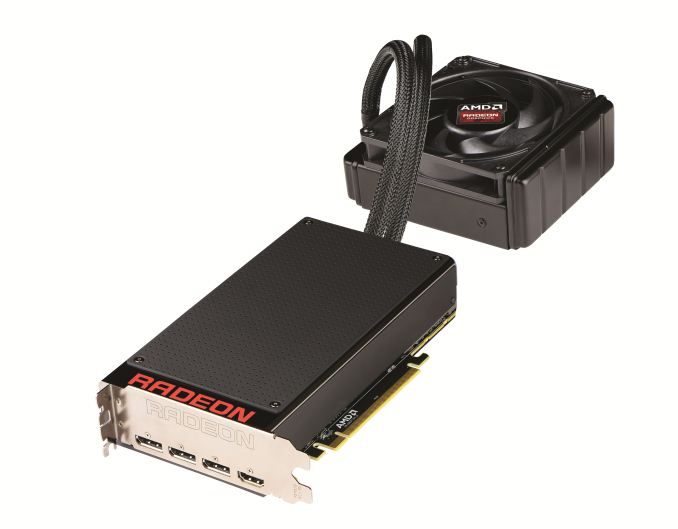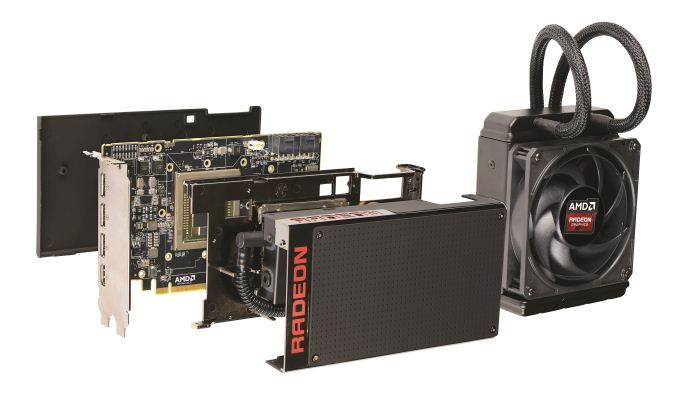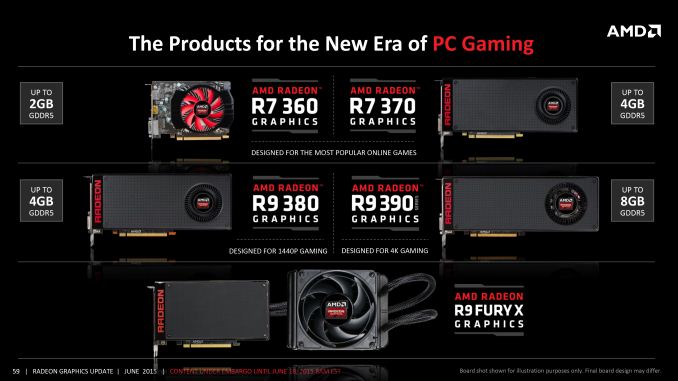AMD Launches Retail Radeon 300 Series: A Prelude To Fury
by Ryan Smith on June 18, 2015 10:35 AM EST- Posted in
- GPUs
- AMD
- Radeon
- Radeon 300

Throughout the last couple of months AMD has been in the process of carefully and deliberately rolling out their latest generation of video cards. In a multi-staged process we have seen AMD engage in a what is best described as a drawn-out teaser and an early technical briefing, announcing their intention to roll out a new high-end video card this quarter, further teasing the public with pictures of the card, and then in the middle of all of that giving the technical press an in-depth briefing on AMD’s key next-generation memory technology, High Bandwidth Memory. While AMD did their best to make sure the details of the cards were kept under wraps – with varying results – AMD definitely wanted to make sure the world would know that their card was coming.
Catching up to the present, earlier this week AMD held their 2015 GPU product showcase, dubbed “The New Era of PC Gaming.” As the latest stage in AMD’s master plan, AMD held a public event in Los Angeles similar to their 2014 GPU product showcase in Hawaii, where the company announced their product lineup ahead of the full launch of the products in question. In the presentation we learned some (but not all) of the details surrounding AMD’s Radeon 300 series, including the numbered products from 360 to 390, and of course the company’s new high-end flagship video card, the Radeon R9 Fury X.
All told the showcase itself was something of a teaser itself – we got prices, but not complete specifications – but we also received confirmation of AMD’s rollout plans. The next stage, coinciding with today’s article, is the formal launch of the numbered members of the Radeon 300 series, which are product refreshes based on existing AMD GPUs, similar to what we saw with the 200 series in 2013. Meanwhile today is also the greater unveiling (but not the launch) of the Fury series, with AMD allowing us to share more details about the new card and its specifications. Following today’s announcements and launches, the Radeon R9 Fury X will be launching in just under a week from now, on June 24th, and then after that the R9 Fury (vanilla) will be launching on July 14th.
| AMD R9 300 Series Specification Comparison | ||||||
| AMD Radeon R9 Fury X | AMD Radeon R9 Fury | AMD Radeon R9 390X | AMD Radeon R9 390 | |||
| Stream Processors | 4096 | (Fewer) | 2816 | 2560 | ||
| Texture Units | 256 | (How much) | 176 | 160 | ||
| ROPs | 64 | (Depnds) | 64 | 64 | ||
| Boost Clock | 1050MHz | (On Yields) | 1050MHz | 1000MHz | ||
| Memory Clock | 1Gbps HBM | (Memory Too) | 5Gbps GDDR5 | 5Gbps GDDR5 | ||
| Memory Bus Width | 4096-bit | 4096-bit | 512-bit | 512-bit | ||
| VRAM | 4GB | 4GB | 8GB | 8GB | ||
| FP64 | 1/16 | 1/16 | 1/8 | 1/8 | ||
| TrueAudio | Y | Y | Y | Y | ||
| Transistor Count | N/A | N/A | 6.2B | 6.2B | ||
| Typical Board Power | 275W | (High) | 275W | 275W | ||
| Manufacturing Process | TSMC 28nm | TSMC 28nm | TSMC 28nm | TSMC 28nm | ||
| Architecture | GCN 1.2 | GCN 1.2 | GCN 1.1 | GCN 1.1 | ||
| GPU | Fiji | Fiji | Hawaii | Hawaii | ||
| Launch Date | 06/24/15 | 07/14/15 | 06/18/15 | 06/18/15 | ||
| Launch Price | $649 | $549 | $429 | $329 | ||
Overall AMD is launching an almost top-to-bottom refresh of its product lineup overnight. Between now and July 14th the company and its partners will introduce cards from $109 to $649, and while there are a few gaps that AMD is almost certainly purposely leaving in place to give them something to announce later this year, overall we’re seeing more or less AMD’s entire hand for 2015 and early 2016 in one go.
As for the subjects at hand today, there are really two stories to talk about. The first is of course the Radeon R9 Fury series, the products that will house AMD’s newest flagship GPU, Fiji. While I won’t butter up Fiji from an architectural standpoint at this time, what Fiji does bring to the table are two very big changes for AMD. The first of these is of course high bandwidth memory, which not only gives AMD more VRAM bandwidth than ever before, but it outright changes how GPUs video cards are constructed. The second big change is that Fiji is just very big. At 596mm2 AMD went right to the reticle limit, putting AMD squarely into the big GPU race.
But before Fury comes the rest of the 300 series. We'll take a look at Fury in due time - while we've been briefed on the subject and have been authorized to discuss it, we want to hold back for when we have the hardware in hand - so our focus for today will be on what's launching today, and that's the Radeon 300 series.
Being released today are five new cards from AMD’s partners, which will form the backbone of the Radeon 300 series from $109 to $429. To our regular readers these parts will be familiar – and to some, perhaps more familiar than they’d like – while for AMD the 300 series represents their 3rd generation of retail 28nm products.













290 Comments
View All Comments
gscindian - Friday, June 19, 2015 - link
How does AMD justify the R9 390X at $429 with just about half the processors and 8 X less bandwidth bus the Fury X. I understand it has 8Gb of ram, expensive as that is. Maybe applying the HBM process to that card would have been better. In fact if I'm guessing correctly the 390X may only need 2Gb of HBM and still perform with a higher bandwidth than the 512bit bus it's working with. My concern is will it be able to use the 8Gb of ram before it hits a bottleneck on the bus.NvidiaWins - Friday, June 19, 2015 - link
Double-stacked memory cards very rarely perform better than the 4GB counterpart, you might see a fps or 2 increase, if any at all. @1080 resolution, no game@full ultra will utilize more than 3GB of Vram, just makes AMD look silly.FMinus - Friday, June 19, 2015 - link
Why don't you look at this from another perspective. AMD is bringing 4 Fiji cards out till the end of the year, Fury X2, Fury X, Fury, Nano, that's 4 cards on the new architecture and the rest of cards it is refreshes.Now what makes this so different from nvidia. They have Titan X, 980ti, 980, 970 and 960. They have one more card in the mix as AMD, if you want to go lower with nvidia, you have to go a generation back.
The difference being the R9 390X is performing around the 980GTX for a lot cheaper. The 970GTX and 960GTX being Maxwell perform rather silly in this big picture. So by the end of the year AMD will have 5 cards (4 new + 1 rebrand) that are performing on the high end.
chizow - Friday, June 19, 2015 - link
The difference is Nvidia didn't slice and permutate GM200 4x and then rebrand Kepler 3x as if they were new parts. You do realize the difference right?The whole point of new generations and new chips is to support new features and improvements across the entire range, vs. the highly stratified and in many ways, deficient limitations of even Fiji (no HDMI 2.0, no HVEC, no DX12_1 etc).
JDG1980 - Saturday, June 20, 2015 - link
According to TechReport, Fiji does indeed support HEVC.Agreed, though, the lack of HDMI 2.0 is a big deal, especially since Project Quantum tries to position Fiji as a set-top gaming option. And there were quite a few people looking forward to Fury Nano for set-top HTPC/gaming systems... until they learned that they wouldn't be able to hook it up to their 4K TVs at anything above 30 Hz.
As for DX12_1, it won't really matter until long after the card is obsolete anyway.
gscindian - Friday, June 19, 2015 - link
I would like to see the 390X with the HBM architecture. Soon 4K will be the standard and if bandwidth holds back the performance of the card I think we should move to the new tech. Also I'm curious to see how a system with half the processors of the high end card with high bandwidth capabilities will work. Will it be able to use the bandwidth, or will the processors just max out and not fill/use it up?milkod2001 - Monday, June 22, 2015 - link
Soon 4k will be standard... Well 1080p is around more than a decade and is still not standard :( I don't think 4k will make it anytime soon even with prices falling down to more affordable levels.We are still far, far away from lets say affordable $350 4k decent quality gaming display and $350 GPU which would drive 4k games with ease. Even if tech was there today i presume vendors prefer to give us all this in very small steps... so they make more money
to article: I'd prefer AMD to come with new tech first even if it was delayed a few extra weeks, have all ready(drivers, benchmarks, GPU available from day 1) then this pathetic more expensive re-brands :(
toyotabedzrock - Friday, June 19, 2015 - link
Disappointed in AMD and this article that reads like an advertisement.Why haven't they switched to 20nm at the very least by now? Has their normal fab really been unable to get their 16nm line up and running? All this PR and rebranding should be used to buy access to 20nm.
jwcalla - Friday, June 19, 2015 - link
It's simple:- There is no 20nm HP node.
- TSMC is working on 16nm FF+ but it won't be available until next year.
There isn't much AMD and nvidia can do in this regard.
JDG1980 - Friday, June 19, 2015 - link
To clarify things a bit, AMD won't be going with TSMC for FinFET. Instead, they will be using Global Foundries, which is licensing the 14nm FinFET process from Samsung.